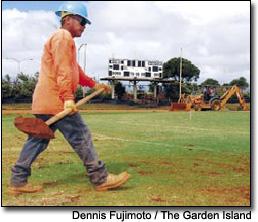Remember Maxine Correa? The former member of the Kaua’i County Council, and before that a member of the Kaua’i Planning Commission, first proposed installing a rubberized track at Vidinha Stadium several years and mayors ago. An athlete herself, Correa even
Remember Maxine Correa?
The former member of the Kaua’i County Council, and before that a member of the Kaua’i Planning Commission, first proposed installing a rubberized track at Vidinha Stadium several years and mayors ago.
An athlete herself, Correa even back then could see the value in having a level playing field, literally and figuratively (although this one will be banked), for the island’s young sprinters, hurdlers and distance runners.
On Monday, Oct. 31, Halloween, finally, work began on the project. The project is expected to be completed by the end of February, 2006, in time for the Kaua’i Interscholastic Federation track and field season.
Once completed, the track will be a 440-meter oval, with a single finish line, instead of the multiple finish lines of the old track, which was a 400-yard layout, said Mary Daubert, county public information officer.
It will meet National Collegiate Athletic Administration (NCAA) standards, making Kaua’i the last island to have a track that meets such standards, she said.
The rubberized track project has been at once a fiasco, political football, scheduling nightmare, money pit of a project, and high-priority project.
Once completed, it will be a source of pride for leaders of county government and coaches of and competitors in track and field, and was pushed for in part because, once completed, it would allow county and high-school officials to host major track events.
The last of the Kaua’i High School faithful had barely made it to the exit gates Friday after their homecoming-game triumph over Kapa’a High before crews from Hawaiian Dredging moved in to begin tearing out the old track and portions of the infield and outfield, and preparing to install the new track.
On Monday and other days this week, no fewer than 20 construction workers were counted within the perimeter of the Vidinha Stadium fence, toiling away on the project.
The idea behind the large work crew, Daubert said, is to take advantage of the current dry weather.
“They’re off and running,” and moving quickly, she said.
The cost of the project, which was supposed to have been done years ago but was delayed by bidding and scheduling problems associated with the use of the field and track by high school and age-group soccer, football, and track and field squads, blossomed from an original $1.4 million to the current $2.4 million, Daubert said.
Funds for the $1.4 million original project cost came in nearly equal portions from state, county and National Park Service sources, but when the price went up, leaders in Mayor Bryan J. Baptiste’s administration had to go before members of the County Council and ask for an additional $1 million, Daubert said.
Earlier this week, the old track curbing was removed, and concrete was poured for a trench drain.
The actual rubberized track isn’t scheduled to be installed until late January, and be in place by mid-February, according to a construction schedule from officials at Hawaiian Dredging Construction Co.
The construction means that Kaua’i High School’s soccer teams, which begin KIF play early next month, won’t have their normal home field for KIF games. The Raider home games will be at Hanapepe Stadium, or, possibly, other venues.


